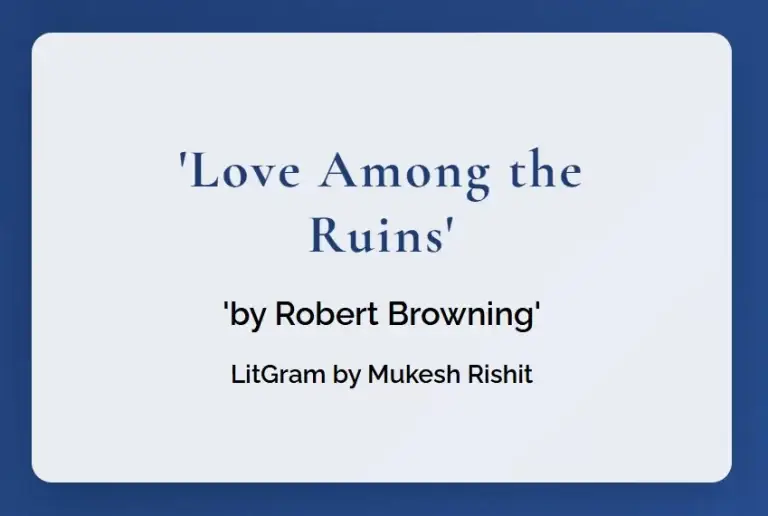Robert Browning, a prominent Victorian poet, is celebrated for his dramatic monologues and complex portrayals of human emotion. His poem, “Love Among the Ruins,” encapsulates his ability to juxtapose grandeur and intimacy, exploring themes of fleeting glory, love, and the passage of time. Published in 1855 as part of his collection Men and Women, this poem remains a remarkable study in contrasts, blending historical decay with the enduring power of love.
In this article, we will go deeper into the poem’s structure, meaning, and deeper themes to understand its significance in Browning’s body of work. Additionally, we will examine how Browning’s poetic style contributes to the timeless appeal of “Love Among the Ruins.”
Overview of the Poem
“Love Among the Ruins” by Robert Browning is set in the ruins of a once-flourishing ancient city. Browning imagines a vibrant past filled with war, splendor, and achievement, now reduced to silence and rubble. Amid this desolation, a modern pastoral scene unfolds, centering around the narrator’s anticipation of reuniting with a lover.
The poem contemplates themes like:
- The transience of material achievements: Civilizations crumble and glory fades.
- The permanence of human connection and love: Emotions and relationships outlive material destruction.
- Nature’s renewal over human decay: The ruins are enveloped by the pastoral countryside.
Robert Browning contrasts the past’s opulence with the present’s simplicity, illustrating that while monuments and empires fall, love endures.
Structure and Form
The poem’s structure is unconventional, employing alternating lines of short and long lengths. This irregular meter mirrors the contrasts Robert Browning explores in the content—past and present, opulence and simplicity. The rhyme scheme is ABAB, lending a sing-song quality that softens the weight of its themes. The variety in line lengths and rhythms reflects the dynamic interplay between love’s emotional power and history’s inevitable decline.
The poem is split into several descriptive and reflective parts. The pastoral opening bridges the gap between the majestic history of the ruined site and the narrator’s personal reflection on love.
Key Themes
1. Decay of Civilizations
Browning evokes the imagery of a once-thriving empire, described as a bustling city of pomp and grandeur. However, these achievements are fleeting. The ruins symbolize the passage of time and the futility of material or political achievements. Browning critiques the often-destructive pursuits of ambition, war, and power, which, though historically significant, ultimately give way to silence and emptiness.
For example:
“Where the quiet-coloured end of evening smiles,
Miles and miles.”
Here, the serene, untouched beauty of nature supersedes the faded legacy of humanity. The empire’s glory is no match for time, leaving physical evidence of decay instead of eternal greatness.
2. Love’s Endurance
In contrast to the temporary nature of human achievement, Browning places emphasis on love as eternal and enduring. The poem gradually shifts from a meditation on loss and ruin to an optimistic conclusion, wherein the strength of love underpins human experience. For the speaker, the personal moment of reuniting with a lover carries far more significance than the ruins surrounding them.
This sentiment is captured when Browning writes:
“Love is best.”
In the end, it is not the splendor of empires or the ambitions of rulers that matter most but human connection. This celebratory vision of love portrays it as a lasting force in a world where everything else fades away.
3. Nature vs. Human Creation
Browning emphasizes the contrast between nature’s persistence and the impermanence of human structures. While the city has collapsed into ruin, the surrounding landscape flourishes:
“And the solitary pastures where our sheep
Half-asleep…”
The imagery of calm, serene pastures overtaking the grand site suggests that life continues despite human impermanence. Nature destroys but also nurtures, reinforcing Browning’s idea that simplicity and intimacy might hold greater value than grandiosity.
Symbolism
Browning employs several symbolic elements in “Love Among the Ruins” to enhance its meaning:
- The Ruins: Symbolize the transitory nature of human ambition. The ruins stand as reminders of the futility of power and grandeur.
- The Setting Sun: Represents the passage of time, the inevitable fading of glory, and the beauty of endings.
- The Meeting of Lovers: A symbol of hope and emotional permanence. In a world of ruin, love remains constant, offering solace and meaning.
Browning’s Perspective on History and Love
Browning critiques the obsession with material success, which often leads to war and destruction, as evidenced by his description of the ancient city. To him, the glory of empire-building is hollow compared to the simple joy of love. The speaker’s focus on his reunion with his lover demonstrates an essential human truth: relationships, not achievements, define personal fulfillment.
The philosophical underpinning of the poem can also be interpreted as an argument for prioritizing the spiritual over the material. By highlighting the persistence of love over historical decay, Browning aligns himself with a Romantic celebration of human emotion and connection, countering Victorian-era industrialism and imperialism.
Browning’s Style and Language
Browning’s language in “Love Among the Ruins” is both vivid and evocative. He contrasts the destroyed city’s grandiose past with the tranquil present, using lush descriptions to create a visual feast for the reader. His interweaving of past and present through imagery mirrors the merging of history and personal experience in the speaker’s mind.
For example:
“That a girl with eager eyes and yellow hair
Waits me there.”
This simple, intimate description of the speaker’s lover paints a striking picture, free of the grandeur associated with the past civilization. It emphasizes the purity and authenticity of love compared to the emptiness of grand historical narratives.
Moreover, Browning’s use of alternating line lengths mimics the shifting moods of the poem—reflective and grand in some lines, tender and personal in others.
Relevance of the Poem Today
“Love Among the Ruins” remains relevant as it addresses timeless human concerns:
- The fleeting nature of material achievements resonates in a world still obsessed with power, wealth, and dominance.
- The enduring importance of human connection speaks to universal truths about relationships and emotional fulfillment.
- Its ecological undertones—highlighting nature’s ability to reclaim and outlast human creations—align with modern concerns about sustainable living and environmental conservation.
Additionally, the poem’s focus on slowing down, appreciating simple joys, and finding meaning in love offers an antidote to contemporary fast-paced lifestyles.
Final Thoughts
Robert Browning’s “Love Among the Ruins” is a masterful exploration of contrasts: the material versus the emotional, the glorious versus the pastoral, and the transient versus the eternal. Through his evocative imagery and poetic style, Browning takes the reader on a journey, urging us to reflect on what truly endures in the face of time.
The ruined city might symbolize the impermanence of empires, but the meeting of lovers at its heart reminds us that love—pure and unadorned—is immune to the forces that erase monuments and accomplishments. In essence, Browning leaves us with the profound realization that “love is the best,” an eternal truth that shapes the human experience across centuries.



1 Comment
Pingback: Twisted Love by Ana Huang: Book Review